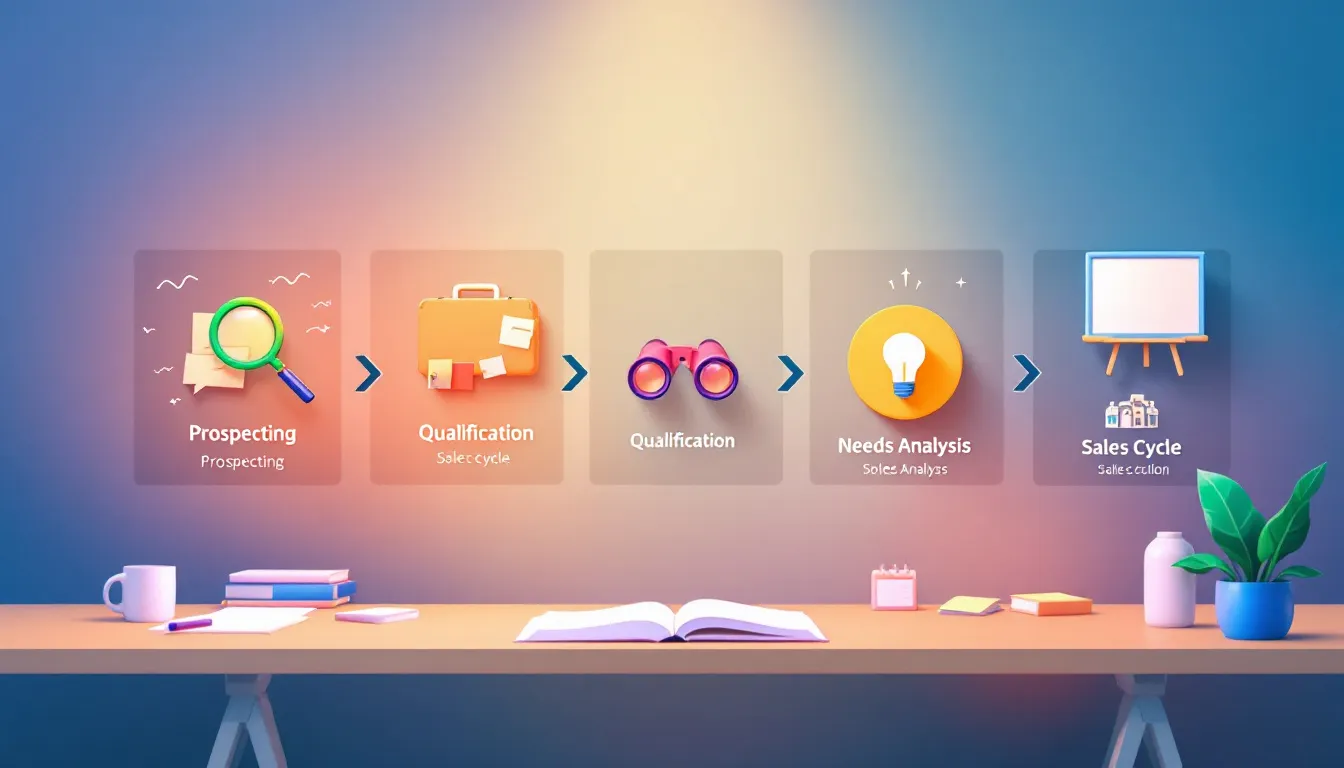|
Getting your Trinity Audio player ready...
|
The sales cycle is a step-by-step process that converts potential leads into paying customers. Knowing its stages—from prospecting to closing the deal—is vital for any sales professional. A well-managed sales cycle can enhance efficiency, improve customer relationships, and boost your success rate.
In this article, we’ll break down each stage of the sales cycle, offering techniques and tips to optimize your sales efforts.
Key Takeaways
The sales cycle consists of seven key stages: prospecting, initial contact, qualifying leads, presenting a value proposition, overcoming objections, closing the deal, and following up to generate referrals.
A well-defined sales cycle enhances conversion rates and enables effective resource allocation, working towards a cohesive approach within sales teams and aligning sales and marketing efforts seamlessly.
Sales cycle management tools and ongoing process optimization are essential for improving efficiency and adapting to changing buyer behaviors, ultimately leading to increased sales performance.
Master the Sales Cycle: Stages, Techniques, and Tips

The sales cycle process is a structured process. Its purpose is to convert leads into customers. It outlines essential steps for nurturing leads and guiding them through the buying process. Understanding this sales cycle important is crucial for any sales rep, as it enhances the buyer’s experience by improving the understanding of the prospect’s needs and stage in the buying process.
A typical sales cycle consists of seven crucial stages, which can influence the average sales cycle length:
Prospecting
Making initial contact
Qualifying leads
Presenting your value proposition
Overcoming objections
Closing the deal
Following up to generate referrals
These stages provide a clear framework for sales reps to follow, helping them prioritize leads and manage their pipeline effectively.
Mastering these stages not only helps in sales forecasting and pipeline management but also in maintaining favorable margins through effective negotiation and a strong value proposition. Identifying ideal customers and tracking key metrics allows sales reps to refine their approach and enhance overall performance.
Introduction
In the dynamic world of sales, unpredictability is the only constant. Salespeople must be adept at improvisation to address the ever-changing demands of consumers. This flexibility is what sets successful sales professionals apart from the rest.
This guide will delve into modern sales strategies that are both practical and effective. Mastering the sales cycle enables you to convert potential leads into loyal customers, boosting both your performance and the overall success of your organization.
Understanding the Sales Cycle
The sales cycle serves as a roadmap for converting leads into customers, outlining essential steps for nurturing leads and guiding them through the buying process. Sales cycle management refers to a structured series of stages that helps sales reps manage their interactions with prospects, ensuring that each step is purposeful and aligned with the ultimate goal of closing the sale.
A well-defined sales cycle impacts sales velocity, as it directly affects how quickly deals move through the pipeline. It provides a framework for next steps, lead prioritization, and a cohesive deal-closing process, all of which are crucial for optimizing sales performance.
Following the steps in the right order allows sales reps to effectively address problems before discussing solutions, enhancing the overall buyer’s experience.
However, it is essential to note that sales cycles often vary between different salespeople or deals, making flexibility and adaptability crucial. Understanding the mindset of the customer before introducing a product is critical in shaping the sales approach, ensuring that the prospect’s needs are met at every stage.
Importance of a Well-Defined Sales Cycle

A well-defined sales cycle is the backbone of any successful sales organization. It facilitates better tracking of team performance and results, optimizing team structure and promoting easier onboarding for new sales reps. A clear framework helps sales teams prioritize leads and understand their stages, resulting in more efficient sales processes.
Understanding customer behavior patterns and guiding interactions step-by-step through a defined sales cycle leads to improved conversion rates. It allows sales leaders to allocate resources efficiently, enhancing overall sales team performance and ensuring that every team member is working towards the same goals.
The overall impact of a structured sales cycle includes efficient resource allocation, enhanced sales team performance, and improved conversion rates. Implementing a well-defined sales cycle allows sales organizations to optimize their processes and achieve greater success.
Key Stages of the Sales Cycle

The sales cycle is a structured progression from identifying leads to converting them into customers. There are typically seven stages in a sales cycle: prospecting, making initial contact, qualifying leads, presenting your value proposition, overcoming objections, closing the deal, and following up to generate referrals. These sales cycle stage provide a regimented framework for customer interactions, helping prioritize leads and understand their stages.
While the number of stages may vary slightly by industry, the fundamental principles remain the same. Each stage plays a crucial role in moving the prospect closer to making a purchase decision. Understanding and mastering these stages is essential for any sales rep looking to improve their performance and close more deals.
Now, let’s delve into each stage in detail to understand their importance and how to navigate them effectively.
Prospecting for Potential Customers
Prospecting is the first and arguably one of the most critical stages of the sales cycle. It involves identifying and reaching out to potential leads who fit your ideal buyer profile. Effective prospecting puts the business in front of buyers and demonstrates proactivity, which is essential for sales success.
To maximize the effectiveness of prospecting, sales teams should conduct thorough customer research and create an ideal customer profile through alignment with the marketing team. Utilizing multi-touch, multi-channel campaigns and personalizing outreach messages can help build relationships with potential leads and move them closer to a purchase decision.
Making Initial Contact with Leads
The primary objective during the initial contact is to create a genuine connection with the lead, rather than giving a full sales pitch. This stage is crucial for building rapport and further qualifying the prospect. Sales reps should use direct contact methods, such as emails, social media, and phone calls, to introduce themselves and start a conversation with the lead.
Personalizing interactions and aligning with the client’s communication preferences can significantly increase the effectiveness of initial contact. By demonstrating enthusiasm and knowledge, sales reps can attract potential clients and set the stage for a successful sales process.
Qualifying Leads
Qualifying leads is a critical stage in the sales cycle, as it ensures that time and resources are spent on the most promising prospects. The goal during this stage is to weed out everyone but the most qualified leads, ensuring that efforts are focused on those who have the need, authority, and resources to purchase. Factors to consider when qualifying a lead include demographic traits, the problem they want to solve, and their decision-making authority.
Sales reps can use various methods to qualify leads, such as researching prospects on platforms like LinkedIn, utilizing the BANT framework (Budget, Authority, Need, and Timing), and asking open-ended questions during calls.
By engaging multiple stakeholders involved in a deal and nurturing leads through email drip campaigns, sales reps can enhance their chances of closing deals.
Presenting Your Value Proposition
Presenting your value proposition is a pivotal stage in the sales cycle. During this stage, sales reps must connect their offer to the prospect’s needs, challenges, and budget to ensure relevance. The story in your sales pitch should relate to the specific pains that your product or service can relieve.
To deliver an impactful sales presentation, it is crucial to tailor it to the prospect’s industry and specific needs, making it engaging and customer-centric. Incorporating storytelling, leveraging social proof through testimonials and case studies, and fielding questions from prospects can help build rapport and address any concerns they may have.
Overcoming Objections
Overcoming objections is an inevitable part of the sales process. Sales reps must understand the root of objections through follow-up questions and active listening. Common objections often revolve around cost, timeline, resources, and service level agreements, which need to be addressed effectively.
When responding to objections, it is important to be patient and empathize with the pain points raised by prospects. Developing active listening skills and validating the prospect’s feelings can move them closer to a purchase decision.
After addressing all objections thoroughly, the next step is to move into the final stage of the sales process to secure the deal.
Closing the Deal
Closing the sale is often viewed as the hardest part of the sales cycle. During this stage, it is important to refine proposals to reach a mutual agreement and address any procurement concerns. Maintaining regular communication through calls and emails, and directly asking prospects if they are ready to move forward, can help close the deal.
Offering discounts can actually decrease the odds of successfully closing a sale; understanding the factors influencing pricing and delivery is key. Continuous engagement and planning based on client readiness are crucial, as 80% of sales require multiple follow-ups before closing.
Following Up and Generating Referrals
Following up after closing the deal ensures continued engagement and can help address any lingering questions or concerns. Post-sale activities, such as account development, are vital for creating loyalty and identifying new growth opportunities with existing clients.
Incorporating referral requests into follow-up processes helps generate more business from satisfied customers. Offering discounts on future purchases for successful recommendations and sending summary emails of the conversation and agreement can serve as effective follow-up strategies.
Sales Cycle Management Tools

Sales cycle management tools are essential for improving sales productivity by organizing and managing accounts and opportunities. These tools streamline workflows and drive revenue by automating data entry, activity tracking, and analytics operations. The primary function of CRM software in sales management is to track and update customer data, providing a comprehensive view of the sales pipeline.
Integrating sales automation platforms with CRM systems enhances customer relationship management by syncing data and improving communication. Advanced sales automation tools can analyze customer interactions and provide actionable insights for improving sales strategies. Aligning with buyers and improving deal health with these tools minimizes closing risks and supports effective sales cycle management.
Automation of repetitive tasks allows sales teams to concentrate on high-value activities, ultimately optimizing the sales cycle management process. Sales cycle management tools support productivity through integrations, automation, and performance tracking, making them indispensable for any sales organization.
Best Practices for Sales Cycle Optimization
Optimizing the sales cycle involves designing each stage with the customer’s needs in mind, ensuring that the sales process is both consistent and flexible. Regularly tracking sales results and implementing changes based on outcomes helps sales teams maintain a competitive edge and improve performance. Understanding the loss rate by stage helps illuminate weak spots in the cycle, allowing for targeted improvements.
Sales metrics, conversion rates for each stage, and overall conversion rate should be tracked to optimize the sales cycle. Consistently tweaking the process is essential to keep the sales process competitive and aligned with buyer behavior. Adopting effective sales techniques and strategies helps sales organizations close more deals and achieve their goals.
Align Sales and Marketing Teams
Aligning sales and marketing teams can lead to substantial revenue increases and measurable benefits. When these teams work together, they create a cohesive strategy that enhances lead generation and nurturing, ultimately driving more sales. Sales enablement equips teams with the necessary resources and strategies for effective selling, ensuring that everyone is on the same page and working towards common goals.
Collaboration between sales and marketing teams is crucial for developing and executing a unified approach to customer acquisition and retention. Aligning efforts allows these teams to better understand the customer journey, create targeted marketing campaigns, and provide valuable insights that support the sales cycle.
Use Social Proof
Leveraging social proof is a powerful way to build trust and credibility with prospects. Customer feedback, testimonials, and case studies serve as effective forms of social proof that can influence potential buyers. Showcasing the positive experiences of existing customers enhances the value proposition and makes a more compelling case for the product or service.
Regularly Measure and Improve
Continuous analysis of sales processes is essential for maintaining competitiveness and optimizing the sales cycle. Tracking sales metrics can illuminate areas needing improvement, allowing sales teams to make necessary adjustments and refine their approach. Integrating measurement, analysis, and training creates a dynamic environment for sales improvement, ensuring that sales reps are constantly evolving and adapting to market changes.
Sales training that focuses on developing specific skills across the entire sales cycle can significantly enhance performance. Regularly measuring and improving processes ensures that sales organizations are always moving towards greater efficiency and effectiveness.
Psychological Aspects of Sales

Mental resilience and emotional intelligence are crucial for long-term success in sales. Sales reps must maintain good mental health to engage effectively with prospects and push through the various stages of the sales cycle. Organizations should encourage mindfulness and a healthy work-life balance to help build resilience in their sales team.
Understanding the emotional values associated with products can help salespeople connect with customers more effectively. Excellent communication and problem-solving skills are essential for enhancing a salesperson’s effectiveness. By developing emotional intelligence, sales professionals can manage their own emotions better and build stronger connections with customers.
Self-reflection and self-awareness are important practices for enhancing a salesperson’s inner game. Setting clear and realistic sales goals can improve motivation and guide sales reps effectively. Hiring individuals with both soft and hard skills is crucial for building a competent and resilient sales team.
Common Pitfalls and How to Avoid Them
Understanding common pitfalls in the sales process is essential for maintaining a smooth and effective sales cycle. A significant percentage of sales meetings may not be perceived as valuable by buyers, indicating a communication gap that needs to be addressed. Common objections during the sales process often revolve around price vs. value, perceived risks, and contract terms, which sales reps must be prepared to handle.
Inconsistent follow-up is a prevalent reason deals fall through, underscoring the importance of constant engagement. During critical decision periods, it is advisable to check in with prospects every three to five days to maintain engagement and move the deal forward. Setting reminders and automating follow-up emails can help ensure consistent follow-up with prospects.
Post-sale activities, such as account development, are vital for creating loyalty and identifying new growth opportunities with existing clients. By focusing on these activities and addressing common pitfalls, sales reps can improve their chances of closing deals and maintaining long-term customer relationships.
Summary
Mastering the sales cycle is essential for any sales professional looking to improve their performance and close more deals. By understanding and implementing a well-defined sales cycle, sales reps can enhance their efficiency, prioritize leads, and provide a better buyer experience. Each stage of the sales cycle, from prospecting to generating referrals, plays a crucial role in guiding prospects through the buying process and securing their commitment.
In conclusion, a successful sales cycle requires continuous optimization, alignment between sales and marketing teams, and a focus on both the psychological and practical aspects of sales. By following the strategies and tips outlined in this guide, sales professionals can achieve greater success and build long-term relationships with their customers. Remember, the key to mastering the sales cycle lies in understanding the needs of your prospects and adapting your approach to meet those needs effectively.
Frequently Asked Questions
What is the sales cycle, and why is it important?
The sales cycle is a structured process that transforms leads into customers by detailing the essential steps for nurturing those leads. Its importance lies in enabling sales representatives to comprehend the prospect’s needs and buying stage, ultimately enhancing the buyer’s experience and boosting sales performance.
What are the key stages of the sales cycle?
The key stages of the sales cycle are prospecting, initial contact, qualifying leads, presenting your value proposition, overcoming objections, closing the deal, and following up for referrals. Each stage is essential for successfully converting prospects into customers.
How can aligning sales and marketing teams improve sales performance?
Aligning sales and marketing teams significantly enhances sales performance by fostering a cohesive strategy that improves lead generation and nurturing. This collaboration ensures all team members work towards common goals, leading to increased revenue and valuable insights throughout the sales cycle.
Why is it important to regularly measure and improve the sales cycle?
It is crucial to regularly measure and improve the sales cycle to remain competitive and optimize sales processes. This practice helps identify areas for enhancement, enabling sales teams to make informed adjustments to their strategies.
What are some common pitfalls in the sales process, and how can they be avoided?
To avoid common pitfalls in the sales process, such as distractions from irrelevant content and inconsistent follow-up, it is essential to maintain constant engagement, set reminders for follow-ups, and prioritize post-sale activities to foster loyalty and discover new growth opportunities.






